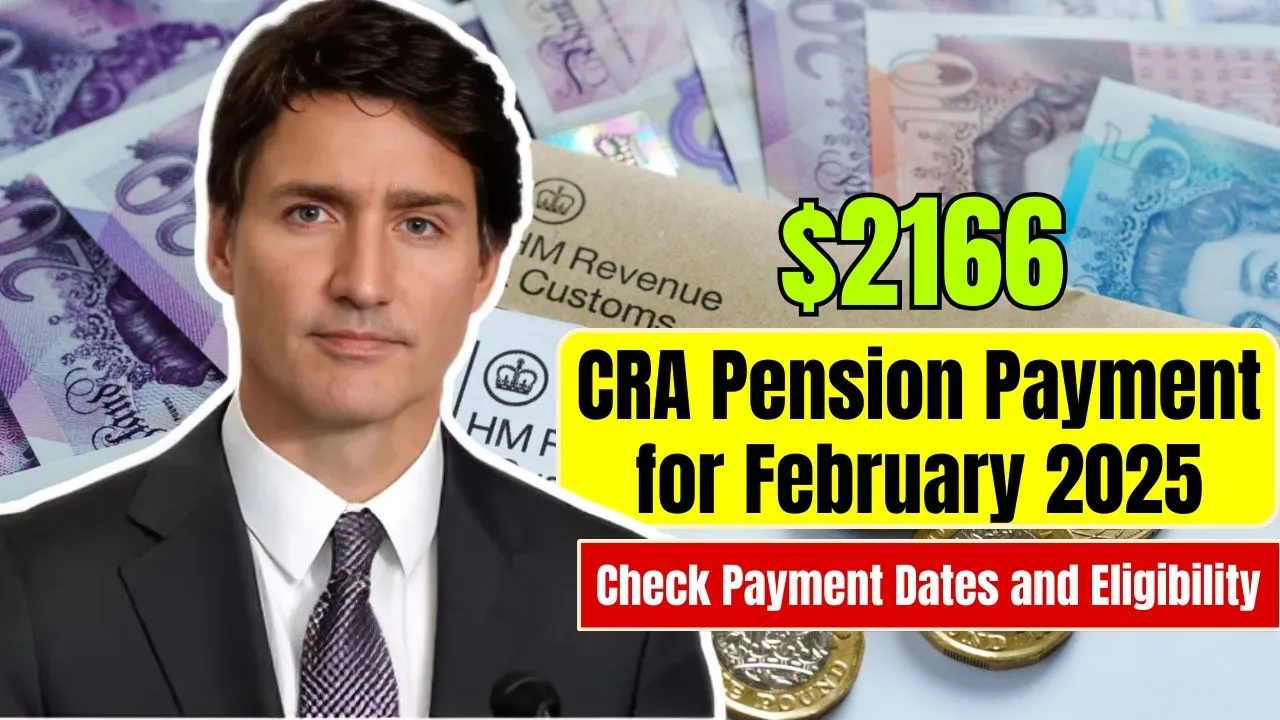CRA Pension Payment $2166 for February 2025: The Canada Revenue Agency (CRA) provides financial support to retirees through pension payments, ensuring seniors receive a stable income after retirement. The CRA pension payment of $2166 for February 2025 consists of benefits from the Canada Pension Plan (CPP) and Old Age Security (OAS). These payments help retirees manage essential expenses and maintain their quality of life.
For those who depend on government pension benefits, it is crucial to stay updated on payment schedules, eligibility requirements, and the amount they can expect. The next CRA pension payment is scheduled for February 26, 2025. Eligible seniors should ensure their information is up to date to receive their benefits without delays. This article provides an in-depth look at the February 2025 CRA pension payment, including eligibility criteria, how to apply, and key details to help retirees plan their finances.
Overview of CRA Pension Payment for February 2025
| Category | Details |
| Payment Date | February 26, 2025 |
| Canada Pension Plan (CPP) Maximum Payment | $1,364.60 per month for new recipients at age 65 |
| Old Age Security (OAS) Maximum Payment | $727.67 per month (ages 65-74), $800.44 per month (ages 75+) |
| Total Possible Pension (CPP + OAS) | Up to $2,166 per month for seniors 75 and older |
| Eligibility for CPP | Must have contributed to CPP, minimum age of 60 |
| Eligibility for OAS | Must have lived in Canada for at least 10 years since age 18 |
| Where to Apply | Online via My Service Canada Account or by mail |
| Official Website for Details | Canada.ca |
Understanding CRA Pension Payments
The CRA pension payment includes two major government-backed programs designed to provide financial security for Canadian retirees:
The Canada Pension Plan (CPP) is a contributory pension that provides retirement income based on the amount an individual has contributed throughout their working years. The more you contribute, the higher your monthly benefit.
The Old Age Security (OAS) pension is available to all seniors who have lived in Canada for at least ten years after turning 18, regardless of their employment history. This program is funded by general government revenues and does not require contributions.
In addition to CPP and OAS, low-income seniors may qualify for the Guaranteed Income Supplement (GIS), which provides extra financial support. GIS payments depend on income levels and are reassessed every year based on tax returns.
CPP Payment Details for February 2025
The Canada Pension Plan (CPP) is designed to provide retirees with a steady income based on their contributions. The amount each recipient receives depends on how long they contributed and how much they earned during their working years.
For February 2025, the maximum CPP benefit for those who start receiving it at 65 is $1,364.60 per month. However, the average monthly payment for most retirees is lower, around $758. Seniors who choose to take CPP before 65 will receive reduced benefits, while those who delay it past 65 will see an increase in their payments.
Individuals who apply for CPP at age 60 will see their payments reduced by 0.6% per month before they reach 65. On the other hand, delaying CPP beyond 65 results in an increase of 0.7% per month until age 70, allowing retirees to receive a larger pension.
For those unable to work due to long-term disabilities, CPP Disability Benefits provide additional financial assistance. These payments are separate from regular CPP benefits and require proof of medical disability.
OAS Payment Details for February 2025
The Old Age Security (OAS) pension is available to seniors who have lived in Canada for at least ten years since turning 18. Unlike CPP, which is based on earnings and contributions, OAS is a universal benefit funded by the government.
For February 2025, seniors aged 65 to 74 can receive up to $727.67 per month, while those aged 75 and older are eligible for up to $800.44 per month. The 10% increase for seniors over 75 was introduced in 2022 to provide additional support for older retirees.
The Guaranteed Income Supplement (GIS) provides further assistance for low-income seniors who qualify based on their income. GIS payments are determined annually and are reassessed based on the recipient’s tax return.
Seniors with a higher income may experience an OAS clawback, officially known as the OAS Recovery Tax. If an individual’s income exceeds $90,997 in 2024, a portion of their OAS payment will be reduced. This threshold is reviewed and adjusted annually.
Eligibility for CRA Pension Payments
To qualify for CPP payments, individuals must have contributed to the plan through employment or self-employment. The minimum age to start receiving CPP is 60, but payments are reduced if claimed before 65. To receive full benefits, seniors should wait until at least age 65, and those who delay past 65 can increase their monthly payments.
For OAS payments, applicants must be at least 65 years old and have lived in Canada for at least ten years after turning 18. Some seniors are automatically enrolled in OAS, but others may need to apply manually. Those who have lived in Canada for 40 years or more after age 18 will receive the full OAS amount.
Low-income seniors who qualify for GIS must submit an application to receive additional support. Since GIS payments depend on annual income, recipients should ensure their tax returns are filed on time to continue receiving benefits.
How to Apply for CRA Pension Payments
- Apply online through My Service Canada Account (MSCA) or submit a paper application by mail.
- It is recommended to apply several months in advance to prevent delays in receiving payments.
- For CPP, applicants must select their preferred start date as early or delayed payments impact the monthly benefit amount.
- For OAS, some seniors are automatically enrolled, while others must submit an application.
- Use MSCA to track application status, receive updates, and ensure a smooth processing experience.
How to Ensure You Receive Your Payment on Time
- Sign up for direct deposit to have payments sent directly to your bank account, avoiding delays.
- Keep personal details updated with Service Canada, including your address, banking details, and other required information.
- Monitor My Service Canada Account (MSCA) to check payment schedules, application updates, and benefit amounts.
- File taxes on time to ensure continued eligibility for OAS and GIS benefits without disruptions.
- Stay informed about quarterly inflation adjustments that may affect pension payments and benefit amounts.
Frequently Asked Questions (FAQs)
Can I receive both CPP and OAS at the same time?
Yes, eligible seniors can receive both CPP and OAS since they are separate programs. CPP is based on contributions made while working, while OAS is based on residency in Canada.
Is OAS available to individuals who never worked in Canada?
Yes, OAS is not based on employment history. As long as an individual has lived in Canada for at least ten years after age 18, they may qualify for OAS payments.
Are CPP benefits taxable?
Yes, CPP payments are considered taxable income. Retirees may have taxes deducted at the source or pay when filing their annual tax return.
Can I work while receiving CPP or OAS?
Yes, individuals can continue working while receiving CPP or OAS. However, if their annual income exceeds $90,997 in 2024, they may experience an OAS clawback, which reduces the benefit amount.
What happens if I delay taking CPP?
Delaying CPP past age 65 results in an increase of 0.7% per month, leading to a higher lifetime payout. This can be a strategic decision for those who do not need immediate financial support.
Conclusion
The CRA pension payment of $2166 for February 2025 is scheduled for February 26 and provides essential financial support to seniors. Understanding the details of CPP and OAS, knowing how to apply, and staying informed about benefit adjustments can help retirees maximize their payments. Keeping personal records updated and filing tax returns on time ensures uninterrupted access to benefits, helping seniors plan for a secure financial future.












